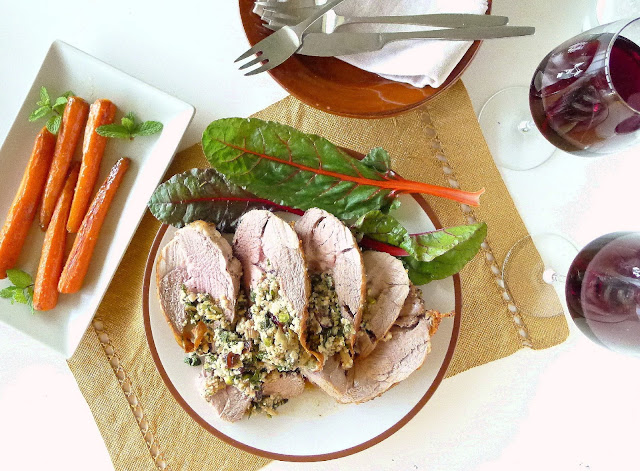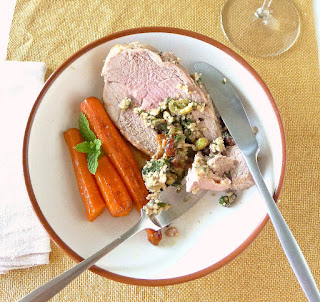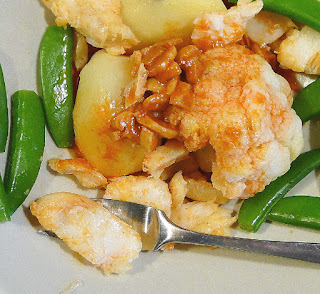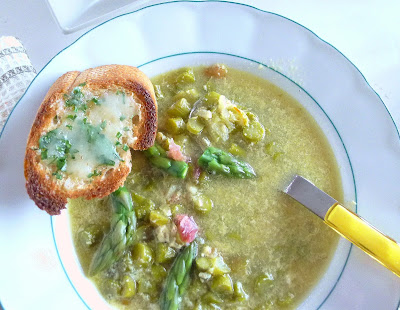Buying a leg of lamb, on a whim, I asked the butcher to bone it for me. He removed the long leg bone without opening out the meat, leaving a pocket for stuffing. Now, what to stuff it with?
I recalled many years ago hosting a mechoui party. Mechoui is the Moroccan roast lamb. I bought a whole lamb and my friend, Dominique, who grew up in Morocco, was in charge of roasting it.
We stuffed the lamb’s cavity with a mixture of cous cous and parsley, maybe some chopped onions. I don’t remember exactly. Once sewed up, the animal was trussed, brushed with olive oil and positioned on a stout stick over smouldering coals. This was an August afternoon. Dominique and his pinche, Mark, turned the lamb for hours, basting it occasionally with salt water to keep the skin crisp. Dripping with sweat, Dominique stripped to his skivvies and turned the garden hose on over his head.
The meat was succulent and deliciously wood-smoke flavored. I served an array of Moroccan and Middle Eastern salads and vegetable dishes to accompany the lamb. What a feast.
Dominique is French photographer Jean Dominique Dallet (http://www.jddallet.com/) He grew up in Fes (Morocco), studied and worked in France and Denmark, before setting up home base in southern Spain, where I got to know him. Dominique clocks around 100,000 miles a year, traveling in search of new images, on assignment for magazines and books worldwide. I rode shotgun on several of Dominique’s forays through La Mancha, where we collaborated on magazine articles.
 |
| Traditional mechoui, whole lamb roasted in clay oven. (Photo by JDDallet) |
Dominique tells me that traditionally mechoui was cooked (no stuffing) in a vertical clay oven, “until the meat is falling off the bones, so that you can eat it with your fingers, without a knife.” Men cook the mechoui, women serve it. Kebabs of liver wrapped in fat might precede the lamb, Salads are the only accompaniment to the roast lamb.
Today in Morocco, he says, a typical mechoui is sent to roast in the neighborhood bread oven.
 |
| Whole roast lamb--mechoui--with accompanying salads. (Photo by JDDallet) |
It was the memory of that mechoui party that inspired me to stuff the leg of lamb with cous cous. Here's my version, boned leg of lamb stuffed with cous cous, chard and pistachios.
 |
| Boned leg of lamb is stuffed with cous cous, chard and pistachios. |
 |
| Roast lamb, a small feast. |
 |
| Stuffing soaks up meat juices. You may need a spoon to serve it. |
Roast Leg of Lamb Stuffed with Cous Cous
Cordero Asado Relleno con Couscous
Cordero Asado Relleno con Couscous
My boned leg of lamb weighed about 2 ¾ pound. (In the US, lamb is marketed much larger, so a boned leg might weigh more than 4 pounds.)
The meat has a deep pocket where the bone was pulled out. Another way to bone the leg is to butterfly it, by cutting it open, removing the bones and cutting horizontally through the thick sections to create a slab of meat that is more or less of equal thickness. The stuffing is spread on the meat and rolled up. Either way, the meat must be tied to keep the stuffing in and give the roast shape.
The meat has a deep pocket where the bone was pulled out. Another way to bone the leg is to butterfly it, by cutting it open, removing the bones and cutting horizontally through the thick sections to create a slab of meat that is more or less of equal thickness. The stuffing is spread on the meat and rolled up. Either way, the meat must be tied to keep the stuffing in and give the roast shape.
 |
| Cous cous and chard stuffing. |
For the stuffing:
½ cup cous cous
½ cup boiling water
2 teaspoons + 1 tablespoon olive oil
½ teaspoon salt
2 cups chopped chard or spinach (to make 1 cup cooked)
1 tablespoon olive oil
1/3 cup chopped onion
1 clove chopped garlic
¼ cup seeded raisins
¼ cup shelled pistachios
¼ cup chopped parsley or fresh cilantro
Freshly ground black pepper
1 teaspoon grated lemon zest
½ cup cous cous
½ cup boiling water
2 teaspoons + 1 tablespoon olive oil
½ teaspoon salt
2 cups chopped chard or spinach (to make 1 cup cooked)
1 tablespoon olive oil
1/3 cup chopped onion
1 clove chopped garlic
¼ cup seeded raisins
¼ cup shelled pistachios
¼ cup chopped parsley or fresh cilantro
Freshly ground black pepper
1 teaspoon grated lemon zest
 |
| Press stuffing into pocket of lamb. |
For the lamb:
2 ½ - 3 ½ pounds boned leg of lamb
2 cloves crushed garlic
1 teaspoon salt
½ teaspoon ground coriander
¼ teaspoon cumin
¼ teaspoon freshly ground black pepper
Olive oil
2 ½ - 3 ½ pounds boned leg of lamb
2 cloves crushed garlic
1 teaspoon salt
½ teaspoon ground coriander
¼ teaspoon cumin
¼ teaspoon freshly ground black pepper
Olive oil
Place the cous cous in a heat-proof bowl. Pour over the boiling water. Add 2 teaspoons oil and salt. Cover and let steam until cous cous is tender, 10 minutes. Fluff the cous cous with a fork.
Cook the chard or spinach in a little water until it is tender. Drain, well.
Heat 1 tablespoon of oil in a skillet. Sauté the onions and garlic until softened, 8 minutes. Add the chard and sauté until moisture evaporates. Add the raisins, pistachios, parsley or cilantro, ½ teaspoon salt, pepper and lemon zest. Remove from heat and stir in 1 cup of the steamed cous cous.
For the lamb:
Combine crushed garlic, salt, coriander, cumin, black pepper and 1 tablespoon oil. Rub this mixture on the lamb, inside and out.
Cook the chard or spinach in a little water until it is tender. Drain, well.
Heat 1 tablespoon of oil in a skillet. Sauté the onions and garlic until softened, 8 minutes. Add the chard and sauté until moisture evaporates. Add the raisins, pistachios, parsley or cilantro, ½ teaspoon salt, pepper and lemon zest. Remove from heat and stir in 1 cup of the steamed cous cous.
For the lamb:
Combine crushed garlic, salt, coriander, cumin, black pepper and 1 tablespoon oil. Rub this mixture on the lamb, inside and out.
Stuff the lamb pocket with the prepared cous cous and chard. (Or, if using butterflied leg of lamb, spread the stuffing on the meat and roll it up.)
 |
| Turkey skewers and twine to close the pocket. |
Use skewers and kitchen twine to close the pocket’s openings. Tie the meat so that it keeps its shape.
Preheat oven to 400ºF. Place the lamb in the oven and lower temperature to 350ºF. Roast the lamb, basting occasionally. Use additional olive oil for basting if the lamb does not have much fat. The lamb is done (medium-rare) when it reaches an internal temperature of 140ºF when tested with an instant-read thermometer. (My 2 ¾-pound roast needed only 50 minutes; a larger piece of meat will take longer.)
Preheat oven to 400ºF. Place the lamb in the oven and lower temperature to 350ºF. Roast the lamb, basting occasionally. Use additional olive oil for basting if the lamb does not have much fat. The lamb is done (medium-rare) when it reaches an internal temperature of 140ºF when tested with an instant-read thermometer. (My 2 ¾-pound roast needed only 50 minutes; a larger piece of meat will take longer.)
 |
| Roast vegetables with the lamb. |
 |
| Allow meat to rest before slicing. |
Remove lamb to a cutting board and allow it to rest for 20 minutes before cutting in thick slices. The stuffing will be loose and may need a spoon for serving.
 |
| Thanks to my friend Dominique Dallet for his photos of traditional Moroccan mechoui. See more of his work at http://www.jddallet.com/. |
More lamb recipes:

































